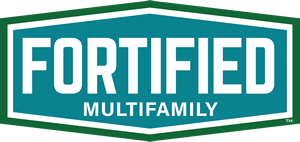General
What is FORTIFIED Multifamily™?
- FORTIFIED Roof™
- FORTIFIED Silver™
- FORTIFIED Gold™
Builders and architects can work with building owners to choose a desired level of protection that best suits their budgets and resilience goals.
What are the benefits of a FORTIFIED Multifamily–designated building?
- Greatly reduces potential for property damage from natural disasters, including hurricanes and high wind/hail
- Protects physical assets—such as the building, equipment, inventories, and tenant improvements
- Increases likelihood of immediate reuse post-disaster, which improves competitive advantage and helps maintain or increase market share
- Reduces environmental impact by limiting destroyed building materials in landfills post-disaster
- Lowers overall cost of recovery; a 2018 study by the National Institute of Building Science (NIBS) shows that for every $1 spent on FORTIFIED Multifamily construction, approximately $4 is saved in disaster recovery expenses.
Where is FORTIFIED Multifamily available?
IBHS is offering FORTIFIED Multifamily designations anywhere in the US.
How much will it cost me to get a FORTIFIED Multifamily designation for my building
The cost will vary based on the size, construction type, location of the building, and the applicant and design team’s efficiency. If inaccurate documentation is provided, multiple reviews by the FORTIFIED Evaluator will be required and could lead to additional costs.
How long does the FORTIFIED Multifamily designation process take?
The FORTIFIED Multifamily designation process will vary with each building project and depends on multiple factors. The process primarily depends on the type of building, percent of project completion for new construction at the time of application, and the construction timeline. The designation process is coordinated with the various phases of construction. A final designation is awarded by IBHS upon completion of the project, typically when a certificate of occupancy is issued.
What kind of confirmation/paperwork will I receive once my commercial building has been designated?
When IBHS has approved a FORTIFIED Multifamily designation, IBHS will send the building owner a package including a letter of acceptance, documentation of designation, and a designation certificate.
If I sell or purchase a FORTIFIED Multifamily–designated building, will the building retain its designation?
Yes, the FORTIFIED Multifamily designation remains with the building for 5 years from its original designation.
Building Criteria
Is my building eligible for FORTIFIED Multifamily?
Eligible buildings include new and existing construction. Building classifications are based on 2018 International Building Code Chapter 3, Section 310 Residential R-2 and R-3 buildings and structures for non-transient sleeping purposes. Examples include but are not limited to apartment buildings, condominiums, and townhomes when the occupants own or lease only the interior, or when operated as commercial properties. For other types of occupancies within R-2 and R-3, use the FORTIFIED Commercial standard. The FORTIFIED Multifamily Evaluator and IBHS have the discretion, and reserve the right, to determine a building’s eligibility for the program based on use and occupancy.
Please note: existing buildings with wood-frame roofs must be constructed in accordance with the 2000 International Building Code or later.
I have multiple buildings on my project site and would like to get designated FORTIFIED Multifamily. Do I need to complete separate applications for each building
Yes, please fill out an application for each building because each building will receive its own FORTIFIED Multifamily designation. For properties that have several buildings with one address, specify each building with an appropriate title. Your designation will specify the address and appropriate title of building. This also helps to prevent confusion when documentation is collected and submitted throughout the designation process.
I have a ballasted roof or vegetative roof and I am in a hurricane-prone region. Can I get a designation
No. Ballasted roofs and vegetative roofs are not allowed for FORTIFIED Multifamily in hurricane-prone regions.
Designation/Compliance Process
I would like to design a FORTIFIED Multifamily building. Where do I start?
Review the FORTIFIED Multifamily Standards and submit an application.
What is a FORTIFIED Evaluator?
A FORTIFIED Evaluator is employed by a third-party company, in agreement with IBHS, who works directly with the building owner or owner’s representative to complete the necessary document reviews and site evaluations. The Evaluator is responsible for providing IBHS with the proper information to complete a FORTIFIED Multifamily designation for multifamily buildings. The company that employs the FORTIFIED Evaluator, and the building owner or owner’s representative sign a “Consulting Services Agreement” laying out the terms of working relationship. FORTIFIED Evaluators are trained and certified by IBHS.
When should I submit documentation?
It is highly recommended to submit architectural, structural, and electrical drawings when completing the application form online. For all other required documentation, the FORTIFIED Evaluator will provide a submission date.
What is an active and current FM RoofNav number?
An active and current FM RoofNav number is a designation associated with a specific FM Approved roof cover system. These roof cover systems are tested to meet specific requirements and include an uplift factor of safety. Approved roof cover systems provide a known performance expectation, therefore material and installation deviations from the approved system are not acceptable. FM Approved systems include a factor of safety for wind uplift.
These approved systems can be used across the US. For more information on the most up-to-date FM Approved roof systems, see www.roofnav.com.
What is a Miami-Dade County Approval and Notice of Acceptance (NOA)?
-
Miami-Dade County approval indicates the roof cover systems have been tested to meet specific requirements and include an uplift factor of safety for hurricane-prone regions. These approved roof cover systems provide a known performance expectation, therefore material and installation deviations from the approved system are not acceptable.
-
The NOA provides detailed information on the roof assembly including the uplift ratings. The uplift ratings include a 2x factor of safety for wind uplift pressure. These approved systems are not confined to use in Miami-Dade County and can be used across the US.

